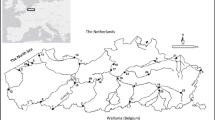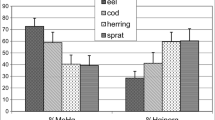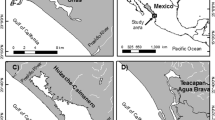Abstract
In the aquatic environment, mercury is readily methylated into its most toxic form of methylmercury. In this form, it enters the aquatic food chain and its concentrations increase in subsequent links, which decreases the quality of fish meat and poses risks to consumer health. Concentrations of methylmercury (MeHg) and total mercury (THg) were determined in the muscle tissues of 64 eel specimens measuring from 59 to 95 cm in length as functions of specimen size and weight. Risks posed to consumers by eel from different length classes were also assessed. The mean concentration of THg in all of the eel examined was 0.179 mg kg−1, but the range was from 0.028 to 0.487 mg kg−1. The mean concentration of MeHg was 0.147 mg kg−1, and the range was also wide from 0.023 to 0.454 mg kg−1. Accumulated MeHg and THg increased with eel body length. The percentage share of MeHg in THg also changed with specimen length, and there was a positive correlation between the concentrations of MeHg and THg. Risk assessment was performed based on the doses of THg and MeHg ingested with fish for several specimen length classes. Consuming the meat of eel measuring 80 cm in length increased the estimated weekly intake (EWI) of THg and MeHg twofold in comparison to that from specimens 60 cm in length and fourfold in specimens exceeding 90 cm in length. The percentage shares of the EWI in the tolerable weekly intake and the target hazard quotient coefficient also increased proportionally. Generally, concentrations of MeHg and THg in eel are below current limits and pose no risk to consumer health as long as the consumption of larger specimens is avoided.

Similar content being viewed by others
References
Al-Reasi HA, Ababneh FA, Lean DR (2007) Evaluating mercury biomagnifications in fish from a tropical marine environment using stable isotopes (delta C-13 and delta N-15). Environmental Toxicology and Chemistry 26:1572-1581
Asefi M, Zamani-Ahmadmahmoodi R (2015) Mercury concentrations and health risk assessment for two fish species, Barbus grypus and Barbus luteus, from the Maroon River, Khuzestan Province, Iran. Environmental Monitoring and Assessment 187:653
Barska I, Skrzyński I (2003) Contents of methylmercury and total mercury in Baltic Sea fish and fish products. Bulletin of the Sea Fish Institute 3 (160): 3-16
Baeyens W, Leermakers M, Papina T, Saprykin A, Brion N, Noyen J, De Gieter M, Elskens M, Goeyens L (2003) Bioconcentration and biomagnification of mercury and methylmercury in North Sea and Scheldt Estuary fish. Archives of Environmental Contamination and Toxicology 45: 498–508
Bjornberg KA, Vahter M, Petersson-Grawe K, Glynn A, Cnattingius S, Darnerud PO, Atuma S, Aune M, Becker W, Berglund M (2003) Methyl mercury and inorganic mercury in Swedish pregnant women and in cord blood: influence of fish consumption. Environmental Health Perspectives 111: 637- 641
Bonsignore M D, Salvagio Manta, Oliveri E, Sprovieri M, Basilone G, Bonanno A, Falco F, Traina A, Mazzola S (2013) Mercury in fishes from Augusta Bay (Southern Italy): risk assessment and health implication. Food Chemistry and Toxicology 56: 148–194
Burger J, Gochfeld M (2007) Risk to consumers from mercury in pacific cod (Gadus macrocephalus) from the Aleutians: Fish age and size effect. Environmental Research 105: 276 – 284
Burger J, Gochfeld M (2009) Perception of risk and benefits of fish consumption: Individual choices to reduce risk and increase health benefit. Environmental Research 109(3): 343-349
Burger J, Gaines KF, Gochfeld M (2001) Ethnic differences in risk from mercury among Savannah River fishermen. Risk Analysis 21: 533–544.
Craig JP, Moreton PA (1986) Total mercury, methylmercury and sulfide levels in British estuarine sediments. Water Research 20: 1111-1118.
Claveau J, Monperrus M, Jarry M, Pinaly H, Baudrimont M, Gonzalez P, Amouroux D, Bardonnet A, Bolliet V (2015) Spatial and seasonal variations of methylmercury in European glass eels (Anguilla anguilla) in the Adour estuary (France) and relation to their migratory behaviour. Environmental Science and Pollution Research 22:10721-10732
Compeau GC, Bartha R (1987) Effect of salinity on mercury methylating activity of sulfate reducing bacteria in estuarine sediments. Apply Environment and Microbiology 53:261-265
Codex Alimentarius Commission (2011) Working document for information and use in discussions related to contaminants and toxins in the GSCTFF. Netherlands
Dixon R, Jones B (1994) Mercury concentrations in stomach contents and muscle of five fish species from the North East coast of England. Marine Pollution Bulletin 28: 741-745
Domongo J, Bocio A, Falco G, Liobet J (2007) Benefits and risks of fish consumption: Part I. A quantitative analysis of the intake of omega-3 fatty acids and chemical contaminants. Toxicology 230 (2-3): 219-226
Dijk H, Fischer ARH, Honkanen P, Frewer LJ (2011) Perceptions of health risk and benefits associated with fish consumption among Russian consumers. Appetite 56 (2): 227-234
Engelberth H, Teisl M, Frohmberg E, Butts K, Bell K, Stableford S, et al. (2013) Can fish consumption advisories do better? Providing benefit and risk information to increase knowledge. Environmental Research 126: 232-239
FAO/WHO (2011) Report of the joint FAO/WHO expert consultation on the risks and benefits of fish consumption. Rome, Food and Agriculture Organization of the United Nations. World Health Organization, Geneva.
Failler P, Van de Walle G, Lecrivain N, Himbes A, Lewins R (2007) Future prospects for fish and fishery products. 4. Fish consumption in the European Union in 2015 and 2030. Part 1. European overview FAO Fisheries Circular (FAO).
EFSA (2012) Scientific Opinion on the risk for public health related to the presence of mercury and methylmercury in food (CONTAM). EFSA 10(12): 2985 http://www.efsa.europa.eu/en/efsajournal/doc/2985.pdf. Accessed June 2014.
Green NW, Knutzen J (2003) Organohalogens and metals in marine fish and mussels and some relationships to biological variables at reference localities in Norway. Marine Pollution Bulletin 46: 362–377
Guzzi GP, La Porta CAM (2008) Molecular mechanism triggered by mercury. Toxicology 244 1-12
He T. Lu J, Yang, Feng X (2007) Horizontal and vertical variability of mercury species in pore water and sediments in small lakes in Ontario. Science of the Total Environment 386: 53–64
Hightower JM, Moore D (2003) Mercury levels in high-end consumers of fish. Environmental Health Perspectives 111: 604-608
Kuballa T, Moellers M, Schoeberl K, Lachenmeier DW (2011) Survey of methylmercury in fish and seafood from the southwestern German market. European Food Research and Technology 232: 737–742
Kinghorn A, Solomon P, Chan HM (2007) Temporal and spatial trends of mercury in fish collected in the English-Wabigoon river system in Ontario, Canada. Science of the Total Environment 372: 615-623
Kwaśniak L, Falkowska L, Kwaśniak M (2012) The assessment of organic mercury in Baltic fish by use of an in vitro digestion model. Food Chemistry 132: 752-758
Kehrig H, Howard B M, Malm O (2008) Methylmercury in predatory fish (Cichla spp.) inhabiting the Brazilian Amazon. Environmental Pollution 154(1): 68 – 76
Lange TR, Royals HE, Connor LL (1994) Mercury accumulation in largemouth bass (Micropterus salmoides) in a Florida lake. Archives Environmental Contamination and Toxicology: 27, 466–471
Magalhaes MC, Costa V, Gui M, Menezes MR, Pinho RS, Santos LR, Monteiro R (2007) Intra- and inter-specific variability in total and methylmercury bioaccumulation by eight marine fish species from the Azores. Marine Pollution Bulletin 5: 1654-1662
Mahaffey KR (2004) Fish and shellfish as dietary sources of methylmercury and the n-3 fatty acids, eicosahexaenoic acid and docosahexaenoic acid: risks and benefits. Environmental Research 95 (3): 414-428
Maggi C, Berducci MT, Bianchi J, Giani M, Campanella L (2009) Methylmercury determination in marine sediment and organisms by direct mercury analyzer. Analytica Chimica Acta: 641: 32-36.
Marrugo-Negrete J, Verbel CJO, Ceballos El, Benitez LN (2008) Total mercury and methylmercury concentrations in fish from the Mojana region of Colombia. Environmental Geochemistry and Health 30: 21–30
Polak-Juszczak L, Komar-Szymczak K (2009) Fatty acid profiles and fat contents of commercially important fish from Vistula Lagoon. Polish Journal of Food and Nutrition Science 59(3): 225 – 229
Polak-Juszczak L, Adamczyk M (2009) Quality and amino acid composition of protein of fish from the Vistula Lagoon. Food Science Technology Quality 3(64): 75–83. Jakość i skład aminokwasowy białka ryb z Zalewu Wiślanego. Żywność. Nauka. Technologia. Jakość 3 (64): 75–83 (In Polish)
Polak-Juszczak L (2012) Bioaccumulation of mercury in the trophic chain of flatfish from the Baltic Sea. Chemosphere 89: 585-591
Polak-Juszczak L (2015a) Selenium and mercury molar ratios in commercial fish from the Baltic Sea: additional risk assessment criterion for mercury exposure. Food Control 50:881-888
Polak-Juszczak, Robak S (2015b) Macro- and microelements in eel (Anguilla anguilla) from the northern regions of Poland. Journal of Elementology 20(2): 385-394
Ralston NVC (2008) Selenium health benefit values as seafood safety criteria. EcoHealth 5: 442-55
Ralston NVC (2009) Introduction to 2nd issue on special topic: selenium and mercury as interactive environmental indicators. Environmental Bioindicator 4: 286-290.
Rooney J K (2007) The role of thiols, dithiols, nutritional factors and interacting ligands in toxicology of mercury. Toxicology 234: 145-156
Ruiz-de-Cenzano M, Rochina-Marco A, Cervera ML, Guardia M (2014) Speciation of methylmercury in market seafood by thermal degradation, amalgamation and atomic absorption spectroscopy. Ecotoxicology Environmental Safe 107: 90-96
Sormo EG, Ciesielski TM, Overjordet JB, Lierhagen S, Eggen GS., Berg T, Jenssen BM (2011) Selenium moderates mercury toxicity in free-ranging fish. Environmental Science & Technology 45: 6561- 6566
Sidhu K S (2003) Health benefits and potential risks related to consumption of fish or fish oil. Regulatory Toxicology and Pharmacology 38(3): 336-344
Simonin HA, Loukmas JJ, Skinner LC, Roy KM (2008) Lake variability: key factors controlling mercury concentrations in New York state fish. Environmental Pollution 154: 107-115
Storelli MM, Giacominelli-Stuffler R, Marcotrigiano GO (2002) Total and methylmercury residues in cartilaginous fish from Mediterranean Sea. Marine Pollution Bulletin 44: 1354-1358
Szlinder-Richert J, Nermer T, Szatkowska U (2014) PAH metabolites in European eels (Anguilla anguilla) as indicators of PAH exposure: Different methodological approaches. Science of the Total Environment 496: 84-91
Tong YD, Zhang W, Hu XD, Ou LB, Hu D, Tianjun Y Xuejun W (2012) Model description of trophodynamic behavior of methylmercury in marine aquatic system. Environmental Pollution 166: 89-97
Usydus Z, Szlinder-Rihert J, Polak-Juszczak L, Konderska J, Adamczyk M et al (2008) Food of marine origin: Between benefits and potential risks. Part I. Canned fish on the Polish market. Food Chemistry 11(3):556–563
Wang X, Satoa T, Xingc E, Taob S (2005) Health risks of heavy metals to the general public in Tianjin, China via consumption of vegetables and fish. Science of the Total Environment 350: 28-37.
Vieira HC, Morgado F, Soares AM, Abreu SN (2015) Fish consumption recommendations to conform to current advice in regard to mercury intake. Environmental Science and Pollution Research 22: 9595–9602
Yamashita Y, Omura Y, Okazaki E (2005) Total mercury and methylmercury levels in commercially important fishes in Japan. Fisheries Science 71: 1029-1035
Funding
The study was supported by a Grant from the National Science Centre (contract 2011/01/B/ST10/05398).
Author information
Authors and Affiliations
Corresponding author
Ethics declarations
Conflict of Interest
None
Rights and permissions
About this article
Cite this article
Polak-Juszczak, L., Nermer, T. Methylmercury and Total Mercury in Eels, Anguilla anguilla, from Lakes in Northeastern Poland: Health Risk Assessment. EcoHealth 13, 582–590 (2016). https://doi.org/10.1007/s10393-016-1139-3
Received:
Revised:
Accepted:
Published:
Issue Date:
DOI: https://doi.org/10.1007/s10393-016-1139-3




